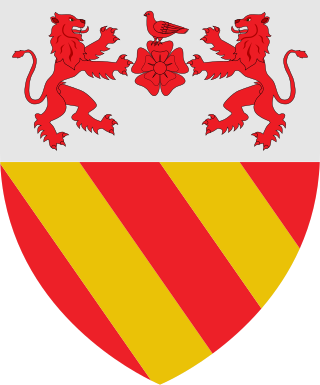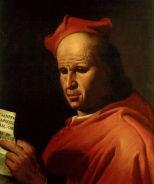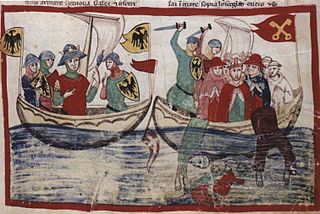This article needs additional citations for verification .(September 2007) |
Luca Savelli was a Roman senator who in 1234 sacked the Lateran in a revolt against Pope Gregory IX. [1] He was the father of Pope Honorius IV.
This article needs additional citations for verification .(September 2007) |
Luca Savelli was a Roman senator who in 1234 sacked the Lateran in a revolt against Pope Gregory IX. [1] He was the father of Pope Honorius IV.
Savelli was born in about 1190, into an old senatorial family; and married Vana Aldobrandeschi. [2]
Savelli became Senator of the Roman Commune and attempted to extend Roman control over Tuscia and the province of Marittima e Campagna, the later part of the Patrimony of Saint Peter. [3] The Roman militia seized and occupied the castle of Montalto di Castro - directly subject to the Church of Rome - to make it a stronghold in the military maneuvers against Viterbo. Gregory took refuge in Rieti and in May 1234 excommunicated Savelli and a number of his supporters and organized a counter-offensive. Much to the surprise of the Romans, Frederick II, Holy Roman Emperor, who was frequently at war with the papacy, sided with the Pope this time. [4]
Frederick II moved from southern Italy with an army, joining the papal troops under Raniero Capocci at Montefiascone. On October 8, the Romans attacked Viterbo, but were beaten back. The defender's then besieged the Romans at a fortress a few kilometers south of Viterbo and Capocci was able to defeat them. Savelli responded by banishing Cardinal Capocci from Rome and declaring the Pope exiled until he should pay compensation for war damages. To this end, he began requisitioning assets from the dioceses of Ostia, Tusculum and Palestrina and other religious institutes of the Patrimony. In April 1235, Savelli was replaced as Senator. [4]
Savelli was again Senator in May 1266. He died in office that year, still attempting to extend Roman authority and recover war damages from the Curia. [4] His tomb is found at the Santa Maria in Aracoeli "Our Lady of The Heavenly Altar", along with his wife, and his son Giacomo (Honorius IV). The papal tomb was actually designed for Luca's wife Vana. Another son, Pandolfo, was the podestà of Viterbo (1275).

Pope Honorius III, born Cencio Savelli, was head of the Catholic Church and ruler of the Papal States from 18 July 1216 to his death. A canon at the Basilica di Santa Maria Maggiore, he came to hold a number of important administrative positions, including that of Camerlengo. In 1197, he became tutor to the young Frederick II. As pope, he worked to promote the Fifth Crusade, which had been planned under his predecessor, Innocent III. Honorius repeatedly exhorted King Andrew II of Hungary and Emperor Frederick II to fulfill their vows to participate. He also gave approval to the recently formed Dominican and Franciscan religious orders.

Pope Honorius IV, born Giacomo Savelli, was head of the Catholic Church and ruler of the Papal States from 2 April 1285 to his death, in 1287. During his pontificate he largely continued to pursue the pro-French political policy of his predecessor, Martin IV.

Pope Gregory IX was head of the Catholic Church and the ruler of the Papal States from 19 March 1227 until his death in 1241. He is known for issuing the Decretales and instituting the Papal Inquisition, in response to the failures of the episcopal inquisitions established during the time of Pope Lucius III, by means of the papal bull Ad abolendam, issued in 1184.

Pope Nicholas III, born Giovanni Gaetano Orsini, was head of the Catholic Church and ruler of the Papal States from 25 November 1277 to his death on 22 August 1280.
The siege of Faenza occurred from August 1240 to April 14, 1241, during the course of the wars of the Guelphs and the Ghibellines. In this military confrontation, the Holy Roman Emperor Frederick II aggressively laid siege to the town of Faenza and successfully captured the city.

The House of Savelli were a rich and influential Roman aristocratic family who rose to prominence in the 13th century, and which included several popes, senators and condottieri. They dominated the city in rivalry with the first generation of great Roman families, the Colonna, the Orsini, the Caetani and the Annibaldi, later being overshadowed by the emergence of the second generation represented by the Chigi, Borghese, Barberini, Doria Pamphili and Sforza Cesarini families.
The 1268–71 papal election, following the death of Pope Clement IV, was the longest papal election in the history of the Catholic Church. This was due primarily to political infighting between the cardinals. The election of Teobaldo Visconti as Pope Gregory X was the first example of a papal election by "compromise", that is, by the appointment of a committee of six cardinals agreed to by the other remaining ten. The election occurred more than a year after the magistrates of Viterbo locked the cardinals in, reduced their rations to bread and water, and removed the roof of the Palazzo dei Papi di Viterbo where the election took place.

Latino Malabranca Orsini was a Roman noble, an Italian cardinal of the Holy Roman Church, and nephew of Pope Nicholas III. Though revered as 'blessed' by the Order of Preachers, his cause for beatification is still within preliminary stages.

The 1285 papal election, convened in Viterbo after the death of Pope Martin IV, elected Cardinal Giacomo Savelli, who took the name of Honorius IV. Because of the suspension of the Constitution Ubi periculum by Adrian V in 1276, this election was technically, perhaps, not a papal conclave. In fact, for the first time since the tedious Election of 1268–1271, the meetings were dominated neither by the Hohenstaufen nor Charles I of Naples. It may even be that the cardinals proceeded so swiftly to an election with the intention of forestalling any intervention from Naples.
Giovanni Battista Savelli was an Italian Roman Catholic cardinal. He was born into the aristocratic Savelli family, which had produced two popes: Honorius III (1216–1227) and Honorius IV (1285–1287) and numerous cardinals carrying this surname: Bertrando, Silvio, Giulio, Fabrizio, Paolo and Domenico Savelli.

The 1280–81 papal election elected Simon de Brion, who took the name Pope Martin IV, as the successor to Pope Nicholas III.

The history of Rome includes the history of the city of Rome as well as the civilisation of ancient Rome. Roman history has been influential on the modern world, especially in the history of the Catholic Church, and Roman law has influenced many modern legal systems. Roman history can be divided into the following periods:

With a long history as a vantage point for anti-popes forces threatening Rome, Viterbo became a papal city in 1243. During the later thirteenth century, the ancient Italian city of Viterbo was the site of five papal elections and the residence of seven popes and their Curias, and it remains the location of four papal tombs. These popes resided in the Palazzo dei Papi di Viterbo alongside the Viterbo Cathedral intermittently for two decades, from 1257 to 1281; as a result, the papal palace in Viterbo, with that in Orvieto, are the most extensive thirteenth-century papal palaces to have survived.

Perugia was a long-time papal residence during the 13th century. Five popes were elected here: Pope Honorius III (1216–1227), Pope Clement IV (1265–1268), Pope Honorius IV (1285–1287), Pope Celestine V (1294), and Pope Clement V (1305–1314). These elections took place in the Palazzo delle Canoniche adjoining the Perugia Cathedral.
Pandolfo Savelli was a member of the Savelli family, a son of Luca Savelli and brother of Pope Honorius IV. He held the office of podestà of Viterbo in 1275 and was on several occasions a Roman senator. In 1297 he strove in vain to mediate peace between Pope Boniface VIII and the Colonna.

Raniero Capocci, also known as Ranieri, Rainier, or Rainerio da Viterbo was an Italian cardinal and military leader, a fierce adversary of emperor Frederick II.
Pietro Capocci was a Roman Catholic cardinal, nominated by Pope Innocent IV in the consistory of 28 May 1244, with the cardinal-diaconate of San Giorgio in Velabro.

Matteo Rosso Orsini, was a Roman aristocrat, politician, diplomat, and Roman Catholic Cardinal. He was the nephew of Pope Nicholas III (1277-1280).

Thomas of Capua, also called Tommaso di Eboli, was an Italian prelate and diplomat. He served as the archbishop-elect of Naples from 1215 until 1216 and then as a cardinal until his death. He administered the diocese of Albano between 1218 and 1222 and was the papal legate in the kingdom of Italy from November 1236 until October 1237. He was the most important of Pope Gregory IX's negotiators with the Emperor Frederick II between 1227 and 1237.

James of Pecorara or Giacomo da Pecorara was an Italian monk, cardinal and diplomat.